How to brew keptinis
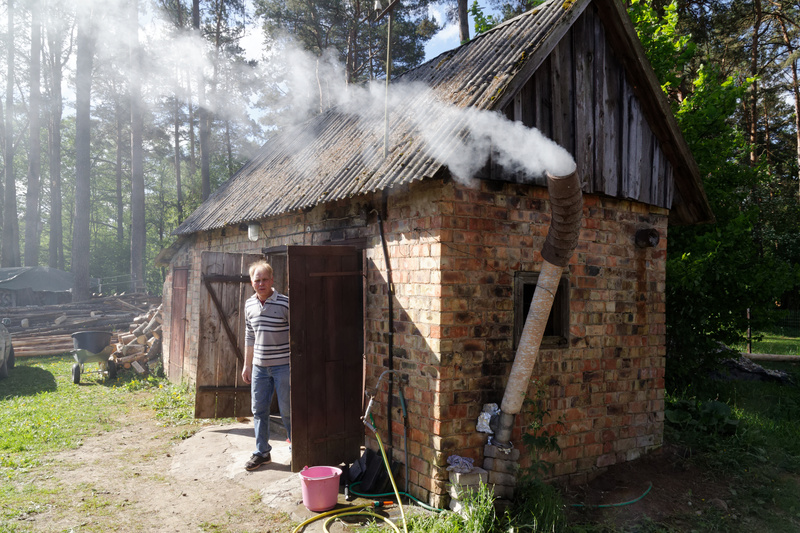
The Jančys family brewhouse |
Keptinis is a little-known Lithuanian style of beer where the mash is baked in an oven. The first farmhouse brewer I ever wrote about was keptinis brewer Ramunas Čižas. A few years ago I put together a description of how to brew keptinis based on ethnographic sources. Martin Warren followed my instructions, but ended up with just black, unfermentable water. So when Simonas invited me to come to Lithuania to see keptinis being brewed, he didn't need to ask twice.
The Jančys family lives in nearby Utena, but often visits their farm in Vikonys, in north-eastern Lithuania, where they come from. And they still brew keptinis in the old way. The brewhouse is a small brick building on the farm, where Vytautas Jančys, who owns the farm, has built a brick oven specifically so he can brew keptinis. The art of brewing keptinis is something he learned from his father and grandfather, so he's a real farmhouse brewer. He used to also make his own malts from barley, dried on top of the oven, until about a decade ago.
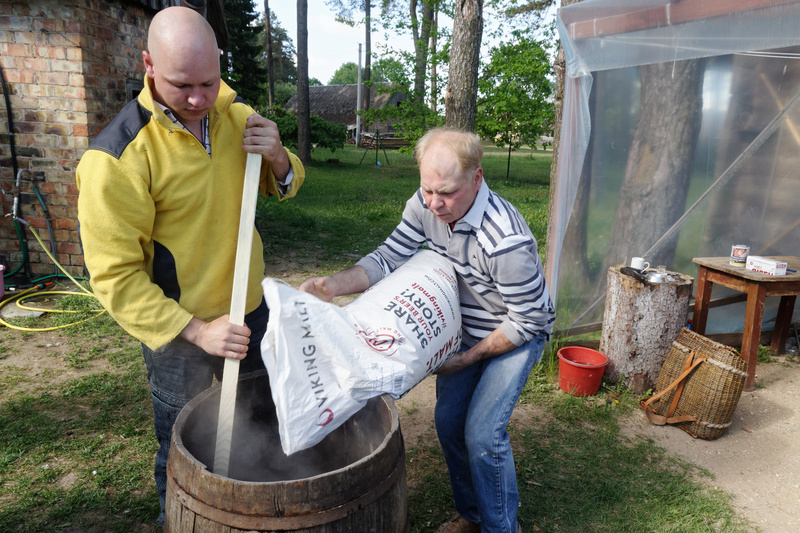
Starting the mash. Ignas on the left, Vytautas on the right |
When we arrived, they had gotten the fire going, and were heating the brew liquor. Outside, in the yard, they'd set up the mashtun, and were getting ready to start mashing.
Vytautas poured a sack of pale malts from Viking Malts in Panevežys into the tun, then added buckets of boiling hot water while his son Ignas stirred the mash. They were using water, not juniper infusion, because this was Lithuania, not Norway. Vytautas kept adding water, and eventually started lifting the mash paddle, staring intently at the drops running off it. Then he would add some more water, then repeat. Finally, he was satisfied. Now they could pack up the mashtun and let it stand.
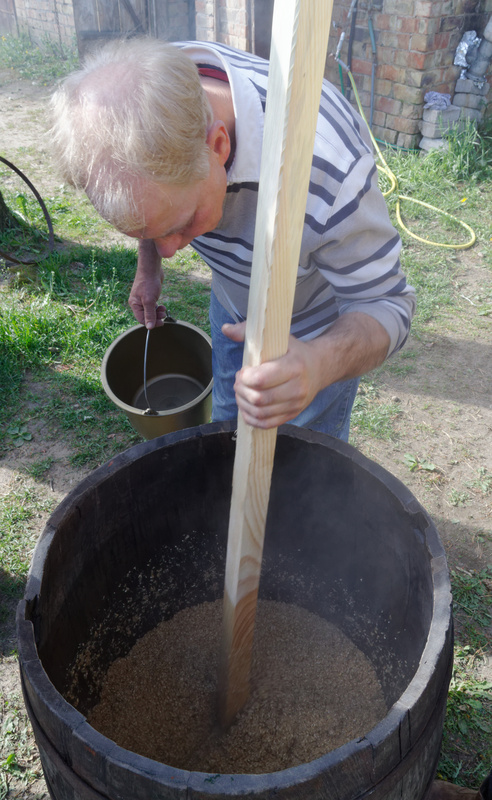
Judging the mash |
But I'd seen no thermometer, so how could he know this was the right mash temperature? I went over to check with my own thermometer. It showed 65C. Simonas saw my surprise and explained to me what was going on. Since Vytautas was using boiling water the temperature of the water was always the same. So if he could hit the right ratio of water to malts, the temperature of the mix would also be roughly right. And this is what Vytautas was doing when he was staring at the paddle: he was judging the ratio of water to malts.
Now the mash needed to rest for an hour, so there was a pause.
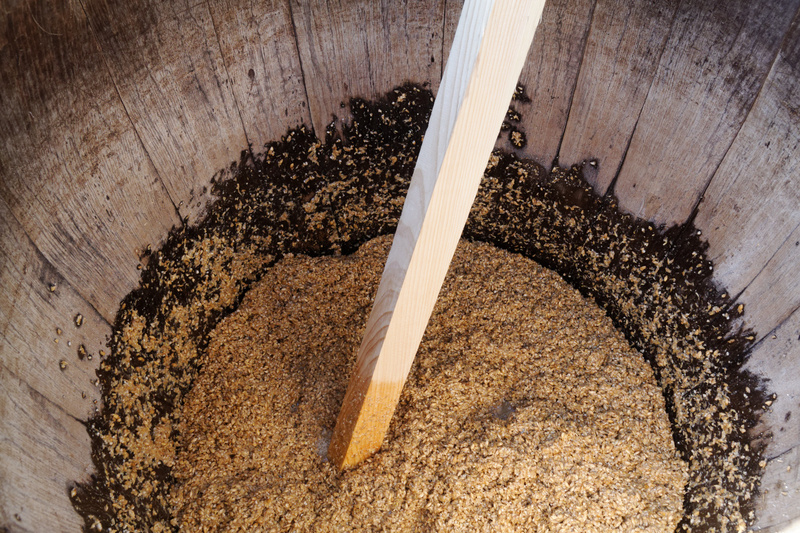
The mash |
Once the hour was up they started scooping the mash out of the mashtun and into metal boxes. These boxes are an innovation that Vytautas has introduced. In older descriptions and ethnographic videos the mash is formed into bread-like chunks where straw is used to help them stick together. The boxes are easier to use since they prevent the chunks from falling apart.

The mash boxes on top of the oven |
Vytautas carried the four boxes in and put them on top of the oven. Then he used a shovel to remove the still-glowing embers from the oven. Putting on a plexiglass mask and big gloves he then put the four boxes into the oven, where they would bake for three hours. How hot the oven was I don't know for certain, but clearly very hot. Simonas thinks the temperature is about 350-400C. This is at the beginning, of course. The fire has been removed, so the oven will slowly cool over the course of the three hours.

Putting the mash in the oven |
Now there was another long wait, so Vytautas took us down into his cellar, where he keeps the beer. The June sun was hot outside, but down here in the cellar it was so cool it felt cold. The beer was stored in stainless steel kegs. Traditionally, people would use wooden casks, of course, but these are much harder to work with.
And there was another reason to prefer steel.
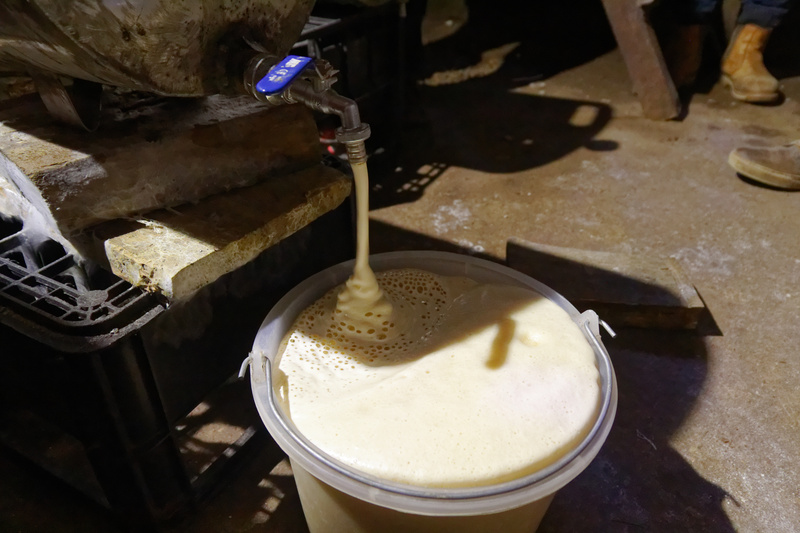
Pouring the beer |
Vytautas put a plastic bucket under one keg and started to pour. Into the bucket ran what looked like porridge. The pressure in the keg was so high that what came out was pure foam, and we had to wait a good while before the foam turned into beer that we could actually drink. This is normal and traditional for Lithuanian farmhouse ale in general. Kegging the beer at the right moment to have enough CO2 in the cask, but not so early that the whole thing explodes is quite tricky, and serving the beer from wooden casks with primitive taps was also non-trivial.
The bucket was carried back up in the sunshine, poured into a ceramic mug, and served. The beer was deep dark red, nearly black, with a tiny beige head. It was quite sweet, with a massive flavour of toast, caramel, and earth. Very round and mild in the flavour, like a less roasted porter or a more toasty or caramelized brown ale. What was most impressive was the depth of the flavour, and at the same time how rounded and mellow it was. Deep notes of caramel and coffee lingered for a long time.

Serving the beer |
It was a deeply impressive beer, and although this was a year ago, I still remember that massive earthy, toasty caramel flavour quite vividly.
While the mash was still baking they started preparing for the lautering. Ignas brought out wooden spiles of alder wood, which were soaked in water so that they wouldn't float up and ruin the filter. Vytautas took us to the barn where a huge plastic bag of straw was hanging under the ceiling, so that the mice wouldn't get into it.
Originally, they used the classic Lithuanian wooden lauter tun with a hole in the bottom and a long rod for opening and closing the hole. However, it's a lot of work to keep these free of leaks and completely clean, so Vytautas has had a stainless steel replacement constructed. They put the wooden spiles on the bottom, then the wheat straw on top.
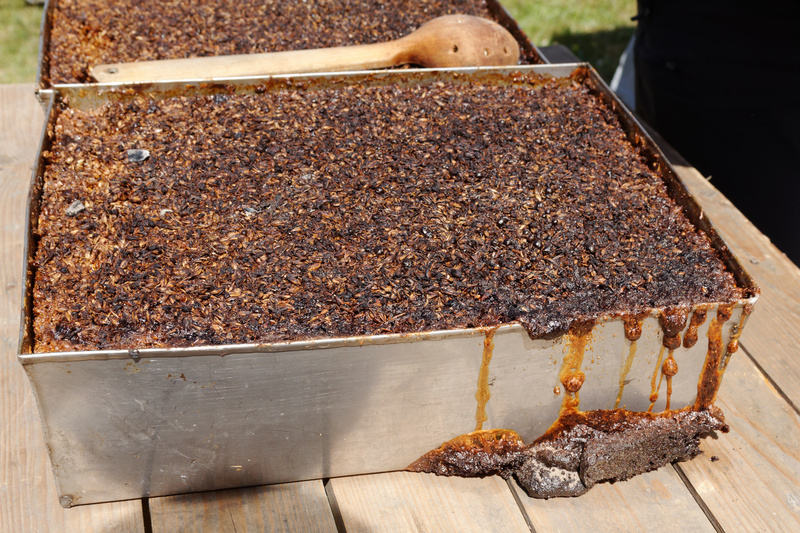
The baked mash |
Now it was time for the mash to come out of the oven. The top of the mash was covered in a hard, dark brown crust. Some of the liquid had boiled over the side of the box, run down the side, and congealed in a hard mass at the bottom. I broke some bits off the top crust and tasted them: massively sweet and toffeeish, with notes almost like honey. They actually tasted like really sweet and good cookies.
And now I realized what was going on and why Vytautas's beer had tasted so different. This is a dark beer made with pale malts, where the colour comes from the baking of the mash. In normal dark beers, the colour comes from drying the malts at high temperature. The heat makes the starch and protein in the malts go through maillard reactions, producing the colour and the roasty flavours. But in this beer it was the mash that had been baked. What went through the maillard reactions was mostly sugar, not starch. So of course the flavour wouldn't be the same.
This is actually quite stunning.
Schwarzbier, porter, dunkel, stout, and all the other blackish beers are made from toasted starch, but keptinis is made from toasted sugar. It's a different kind of dark beer. And, as the beer we'd tasted showed, one that could be really, really good. To make a proper keptinis you should really use Lithuanian malts and yeast, and not boil the wort, but the baked mash concept can be used to make many kinds of beers, not just a classic Lithuanian keptinis.
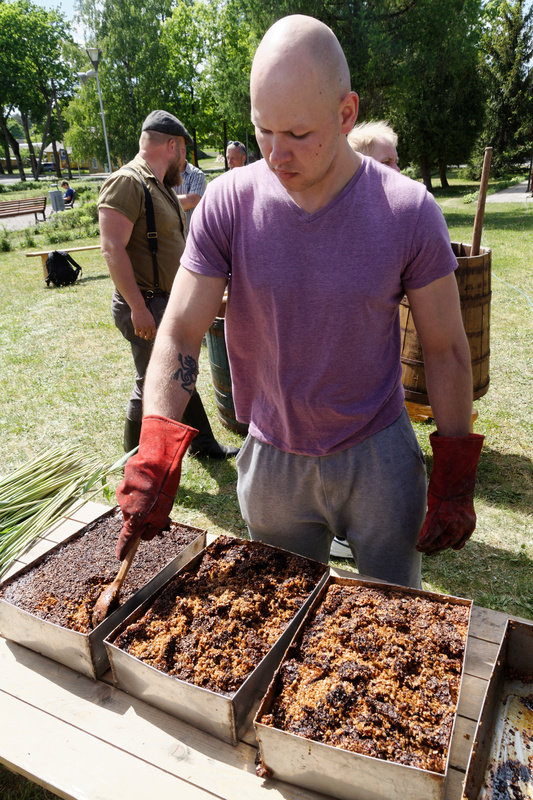
Breaking the crust |
Once the lauter tun was prepared, Ignas took a large wooden spoon and started breaking up the crust on the boxes. Then the fairly dry mash was scooped out on top of the straw. Ignas then got hot water in plastic buckets, and poured it on top of the mash. They let it stand for about 20 minutes, then let the dark brown, blackish wort run off slowly into a porcelain bowl.
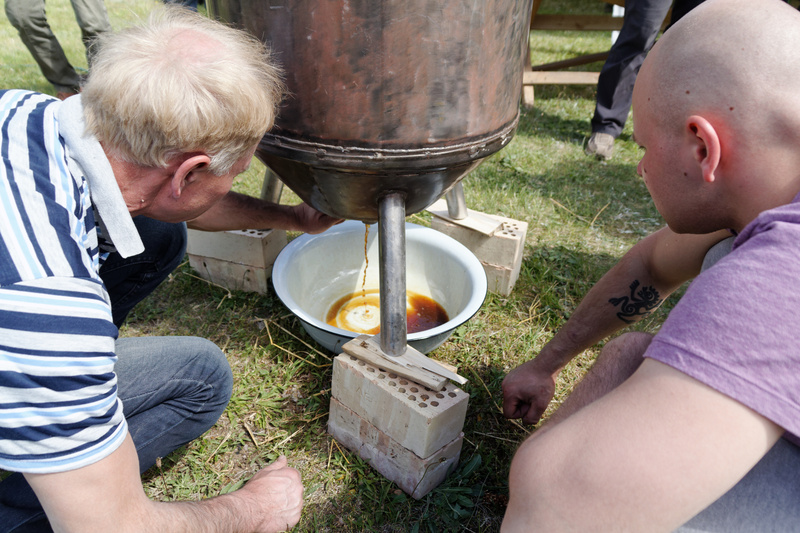
Wort coming out |
Meanwhile, they were boiling hop tea in a small pot. Keptinis, like all other Lithuanian farmhouse ale, is raw ale, so in order to get alpha acid out of the hops they are boiled in water. This is a simple solution that doesn't require a big kettle and saves a lot of energy. The little pot reeked with lovely hop aroma, and after half an hour or so the hop tea (in Lithuanian, "apyny arbata", literally hop tea), was ready. They used just bittering hops for this beer, but they told me that if you want more hop aroma you can put some of the hops in cold water to draw out the aroma.
Once the wort had been run off it was cooled with cold water from a garden hose, and poured into the fermentor. The Jančys family no longer have their own yeast, and have been using commercial yeast for the last 30 to 40 years. Before that they did have their own.
And with that they were done. Within a few days the beer would be finished fermenting, and transferred to cask.
For me this was quite an experience, to see a completely new type of brewing process. Today, keptinis is an ultra-obscure style of beer, made only by a few farmhouse brewers in north-eastern Lithuania, and by three commercial breweries. One being Ramunas Čižas, the other two being Dundulis and Kupiškio.
Of course, keptinis is not the only oven-baked style. This must have been quite close to how the Seto people used to brew. And, as it turns out, the full story is a good bit bigger than just the north-eastern corner of Lithuania. The summer of 2017, it turned out, was the summer of oven-baked beer.
We'll dive into that story over the next few blog posts.

The church in nearby Andrioniškis |
Recipe
The recipe is for 130 liters of beer, which is what they usually make. 50 kilos of pale malts. Mash in at 65C, then let the temperature drop to 58C over an hour. pH at the start of mash: 6.1.
Then put the mash into an oven, where we think the initial temperature should be 400-350C. Make sure there is a good amount of water in the mash. Let the temperature drop over three hours while the mash bakes.
Take 120g bitter hops (14% alpha acid) and 50g aroma hops (5-6% alpha) and boil them for 30 minutes in 2 liters of water. There was no very clear aroma of hops in the beer, so some noble hop will probably work best.
Then lauter in the usual way, cool the wort, then pitch. They have used both modern dry yeast (probably Safale S-04, 19-25C, 2-4 days) and #16 Simonaitis (24 hours). To be honest, the yeast was not very prominent in the beer I tasted, so something fairly neutral should work. This beer isn't really about the yeast profile, anyway.
The tricky part here is to judge when the fermentation is sufficiently done, and then transfer to closed keg where it should work up natural carbonation. If you keg too early things can blow up, and if you keg too late you'll get flat beer.
In older times it was custom some places in Lithuania for people to ask their neighbours over to help judge if the time had come for kegging. If they decided it had come typically everyone would be served beer (kind of like oppskåke) and a party might well develop.
Similar posts
Figuring out how to brew keptinis
I visited Vikonys in Lithuania and saw how the Lithuanians there brew keptinis
Read | 2020-04-12 12:20
Keptinis, Lithuanian baked beer
Farmhouse ale styles are known for being messy, sprawling, ill-defined categories to the point where it can be questioned whether they really are styles at all
Read | 2015-04-20 12:36
The great stove
As I wrote in the previous blog post, keptinis is a unique style of beer from north-eastern Lithuania where the mash is baked in an oven
Read | 2018-07-25 18:22
Comments
Merryn Dineley - 2018-07-11 15:48:05
This is, as you say in the blog, stunning. It's a very interesting technique. Getting colour and flavour in the beer from baking the mash. I reckon this could be what that ancient Egyptian "beer bread" was like. Is this how they made it. I shall have a look at the descriptions and art all over again, with keptinis in mind. Archaeologists have argued (as they do) about beer bread for many years. It's said that the ancient Egyptian beers were of several different colours, from red to black and many other colours in between. This technique could explain it. Of course, other aspects of the brewing process have an influence on colour and flavour, such as the kind of malt used for example.
Charles M Richardson - 2018-07-12 05:47:30
This is really great! Such a wealth of information, too! I have been a brewer of mead and beer for twenty plus years. My special recipe is a a braggot. I have been interested in making some traditional farmhouse beers from these regions for a while now. Thank you very much for these informative articles.p
Mika Laitinen - 2018-07-12 06:31:51
Fascinating! Oven-baked beers have been also made in eastern part of Finland, but there the bake was often made from a mixture of unmalted and malted grains (usually rye), with higher proportion of raw grains. Have you heard of similar economical use of malt in the Baltic oven beers?
Lars Marius Garshol - 2018-07-12 06:33:51
@Mika: As far as I know, this use of raw grain is something that was completely unique to eastern Finland. I've never heard about it anywhere else.
B Royal - 2018-07-12 11:24:58
Your description of "the beer was deep dark red, nearly black, with a tiny beige head. It was quite sweet, with a massive flavour of toast, caramel, and earth. Very round and mild in the flavour, like a less roasted porter or a more toasty or caramelized brown ale" is nearly identical to the homebrewed version I did. My version was not quite as dark, however it was certainly well into the "brown ale" range in terms of color. Additionally, the beer finished with quite a high final gravity. I assume much of that is due to the oven "mash" causing many unfermentable sugars to be formed and, as you mention, "the malts go through maillard reactions, producing the colour and the roasty flavours."
Thanks for your research!
Nik - 2018-07-12 19:03:46
Really fascinating. I don't think I've been this curious to try out a new technique in a beer of my own in ages.
Do you have any more guidance on mash thickness? It looks quite thick and the used boiling water as their guide, but aside from that there isn't much direction aside from a "good amount of water" in the mash.
There's also something very traditional-German about the use of boiling water to achieve the right mash temp. That was the purpose of old-school decoction as well. I think I'll experiment with brewing a sort of dark lager with 100% pale malts.
B Royal - 2018-07-13 02:01:42
Nik - From my experience, I used just enough water to get a "dough-like" mass from the grist. It wasn't much at all compared to my usual mash. Like the mash in the post, mine bubbled over, however I probably didn't use quite as much water as they did judging by the pics.
Where I differed from tradition was that I boiled mine after I put the cakes into my mash tun and sparged. I have not tried to do it as a raw ale.
Also, if you're going to try to produce a dark lager style of beer, I'd caution you that in my experience this produces a FAR sweeter beer than you're likely used to; my SG was 1.073 and FG was 1.029 using Mangrove Jack's Burton Union yeast followed by S-05. I was shocked at how sweet mine was and I didn't bake it at 400*C, closer to 475*F. I got great overall efficiency, however the longer chain (unfermentable) sugars seriously affected the FG. Were I to do it again, I'd likely only bake half my mash at a higher temp rather than all of it, but I'd probably put at least part of my grist onto a much shallower pan to get more color with less of the grist being baked.
My thought on the high FG was that the residual sugars MAY be worked on by bacteria or other wild yeasts rather than traditional Sacc. cerevisiae.
Cody Gabbard - 2018-07-13 16:40:15
Hi Lars, really love it when you include a breakdown of the recipe for recreation purposes. Question about the proportions, since I'm sure it really matters what the thickness is when you go to bake the mash. Do you know what the ratio of water to grain was for the initial mash? Although I suppose one could figure it out by continuing to add boiling water until you reach 65 C? Cheers!
Fer - 2018-07-14 10:09:45
Wow, really amazing story. I definitely plan on brewing a beer with some processes used here.
Thanks!
Nik - 2018-07-15 15:40:03
Thanks B Royal. My train of thought was definitely to only try baking a portion of the mash for a Dunkel-type beer. Somewhere in the range of 25-40%, and a long, low temp infusion for the rest to make sure the rest of the wort is highly fermentable. I have a suspicion that I'll still be surprised by the sweetness, but that's what experiments are for.
Bill - 2018-07-19 18:57:40
Hi Lars, this is really a great looking beer, gonna take a stab at making some this weekend. The 327 blog and the above (394) blog are somewhat contradictory in proportions. Any tips on this? Or is it a case of every farmer just does it his own way? Thanks. Bill
Lars Marius Garshol - 2018-07-20 13:08:45
@Bill: Yes, I think it's a case of the proportions varying with who's making it, and what occasion they're making it for. Overall, I would recommend going with the recipe that's in this blog post, since we know that one works and gives good beer.
Dean Volungis - 2018-07-27 13:55:02
I don't see any milling of the grains mentioned. Are they using uncrushed malted barley in the mash?
Lars Marius Garshol - 2018-07-28 10:08:50
@Dean: Simonas brought a bag of already-milled malts to the brew session, so that's why it's not mentioned. I don't know how they normally mill the malts, but milling the malts has been nearly universal in farmhouse brewing.
Inge - 2018-08-02 12:09:49
I brewed this yesterday, though only a 15L batch. It was a strange and very messy experience. I used around 110% hydration in the mash and used my home oven at 250C for 45 minutes and then let it cool slowly by setting the thermostat to 160C and kept it for another hour (wanting to continue the maillard and caramelization processes throughout the bake). The water caused some boil-over like in the article, but in general the hydration was in the right ball park as the mash did not bake dry.
Efficiency was pretty bad (around 55-60%) so next time (if there is one) I will mash a bit longer. Making such a small batch was hard and the resulting wort was closer to 20L than 15L, so it will be weaker than intended.
Please note that it is hard to find a properly sized baking container - I used a number of bread pans and cast iron pots instead. My apartment is currently full of syrup and caramel stains and need a proper cleaning.
The taste of the baked mash was great and I'm really looking forward to the finished beer. Thank you so much for this article, Lars Marius!
Mike Lundell - 2018-08-02 14:36:13
Wow, this is some cool stuff! As a professional brewer for 20 years, I havenít done a lot of research into farmhouse brews, just stick to what pays my bills. Eye opener for certain. Iím seriously going to give this a go. Thanks for this great article!
Rik van Schendel - 2018-08-22 12:05:38
Thanks for this detailed description! I used it to brew my own Keptenis variant...read about my experiment at http://pixelhomebrew.com/2018/08/22/keptenis/ I did a 30min boil and used different hops, yeast. so it is not a traditional keptenis. The beer is still fermenting, so an taste update will follow asap.
Inge - 2018-08-27 17:37:02
I've made a second batch of this now (this beer is awesome!) and I wonder how this is really a raw beer. The baking process causes the mash to reach boiling point for an extended period of time (the boil over pictures seen here is exactly as my mash baking turned out). I measured the inside of the bake this time around and it was around 95-97 C and I can but assume that this is the case for the bake in this article. The finished beer is indeed thick and creamy, but how can this be due to proteins as in a raw beer when the mash is subject to condition that would cause proteins to coagulate?
Damien - 2018-08-29 15:04:11
Hi, and thank you very much for this post.
I ran into your blog quite randomly looking for info about farmhouse ale, and this kind in particular is so badass I actually want to brew it!
I just can't figure out exactly the lautering part since I don't know much about farmhouse ale (quite hard to find in France): if I understood correctly the broken mash breads are poured on a layer of wheat straw, is it for a better filtering purpose? And how much of boiling water do you need to pour, just enough to get the volume you desire? Aren't there much risks of infection with a raw ale? (maybe it is something desirable?)
Also, does this style allow a priming fermentation as I can only bottle my beer?
Thanks
Bill - 2018-09-27 14:30:42
Hi Lars, made the baked bread beer, did as a raw ale, too, so no wort boiling. Made it my own by splitting between rye and pale ale malt. Chose the hops to simulate what the farmers might use. Kept the bitterness low. But a very interesting beer. Silky smooth mouthfeel. The baked grains were incredibly sweet. I wanted to eat them as a cookie. Came out to 2.6% alcohol, kept it low carbonated to style but didn't quite taste right. I left to lager in my chilling refrigerator for a few weeks and increased the carbonation to a modern beer level. I tried last night and the flavor improved greatly, very nice and very drinkable. There might have been a second fermentation (seems stronger, lol) but the improvement is definitely from having more carbonation, but the lagering seems to have cleared it up, too, hence taste improvement. My sense is this beer will improve over time, as might happen on a farm. BIll
Alkis Agathokleous - 2019-01-26 06:33:37
Thanks for the great article.
Michael - 2019-08-28 10:07:33
Lars- first of all, thanks for this incredibly rich resource. I was in Lithuania (and Latvia) last week and had the opportunity to try some of your recommendations (including Jovaru which kind of blew my mind and something that starts with a G that rivals the best saisons Iíve tasted). I really liked the Dundulis Keptinis they serve at äpunka as well and wanted to try my hand at it with some Vienna I have lying around.
I saw on Twitter youíve been doing a lot of experimenting to get this right at a homebrew scale in a modern kitchen- any important tips from that learning process?
Also- when does the book come out? Iím really looking forward to getting my hands on a copy.
Lars Marius Garshol - 2019-08-28 11:52:41
@Michael: Happy to hear you enjoyed the trip.
The trick with keptinis is to get caramelization of the mash in the oven. I would try setting the oven at 180C/190C and bake until the outside turns roughly the colour you see in the photos here. Then stop. It will probably take ~3 hours.
The book will be out 1 April 2020. More information soon.
Earle Douglas - 2020-01-13 05:51:58
Since reading your blog on Keptinis I've been keen to make a version which I did yesterday. It's a combination of the method you described and then finished off using the Brew In A Bag method. I'm not quite brave enough to leave it as a raw ale so finished it with a boil with hops. It's currently fermenting on the Simonaitis strain so I'm really looking forward to tasting it. I did a write up here https://aussiecraftbrewing.com.au/thread/2699/keptinis-lithuanian-baked-beer Thanks again for all your work in this area. Cheers, Earle
Dan Goodwin - 2020-04-30 01:08:36
How in the world do you find an oven that will go to 350-400C or about 650-700 F? Interesting beer!
Jonathan Rondeau-Leclaire - 2020-12-07 20:58:26
Hi! I was wondering if the baked-mash technique had a name (in lithuanian) that you know of?
Thanks :)
Lars Marius Garshol - 2020-12-07 21:05:29
@Jonathan: I'm not aware of any name for the technique itself. Given that "keptinis alus" means "baked beer" I presume they just call it "baking".
Gareth - 2021-03-26 11:13:55
Hi Lars. Whats your suggestions on hopping with Kveik? Whirlpool vs dry hop after fermentation or during fermentation.
Lars Marius Garshol - 2021-03-26 12:12:39
@Gareth: I don't think you need to worry about the difference between kveik and ordinary yeast as far as hop treatment goes. Just do as you would do with normal yeast.
Robert Boyle - 2022-08-05 22:50:46
Thank you for all of your work we have a large brick baking oven and I will be using your work to make our first beer
Jared - 2023-09-25 03:40:17
I imagined this as a technique independently as a way to deal with my lack of all-grain brewing equipment, and from something I read about cornbread beets (I brew gluten-free). It worked pretty well, but I was excited to discover this as a real style as well as picking up some extra ideas.
For mine, I've made a pale unhopped ale based on an adapted historic cornbread recipe and a darker, maltier beer from unmalted grains (added enzymes), the darker beer was really good. I threw the whole loaf in the fermenter and added water and yeast.